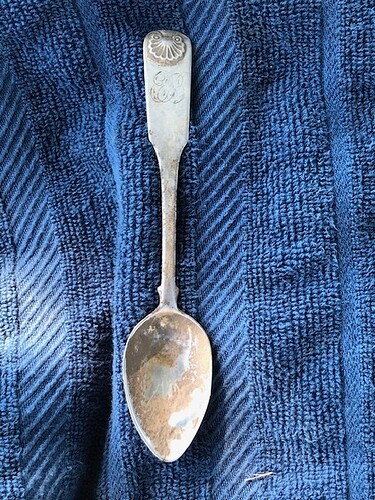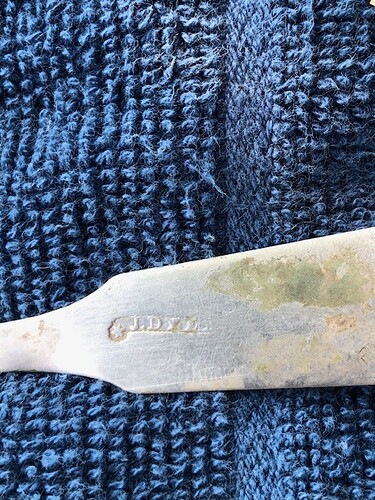So plain fiddle and shell, American, probably New York, NY and likely after 1850. You don’t say if it is coin silver or plate. The absence of a mark saying silver or .900 (%age of item not base metal) does not mean it is plated. Agree with Jeff unlikely to be sterling (.925). Might not be either plate or coin might be nickel silver or even Britannia Metal.
Back then even very modest hardware stores used to order plated flatware from manufactory and stamp it with their name as seller.
Took a quick look through New England and New York directories and found a few possibles. Not much wear on the spoon so someone was perhaps having tea outside on a warm summer day. The grass had been cut but not mown, it was likely a family tea (too late in the season for much else) servants has set up the teapot and cream jugs on a large tray and sandwiches were on offer. The ladies were dressed for the warmth of the mid to late August day in their fine floral printed cottons with loose fitting sleeves and taken in high in the waist.
The war between the States was probably on and the men were away either dealing with matters of war or attending to their business in town. The women were worried, perhaps about lack of news from the front or perhaps about domestic matters. An Illness, a difficult delivery, staff shortages caused by call up. A gesture is made and a spoon falls from the cup and saucer which tilts. It lands unnoticed and quiet in the grass and remains there long after the party is over and the tea things put away. Nobody notices the missing spoon until the end of the summer season when a pantry inventory is taken. The serving maid servant has quit her domestic duties for a factory in town making munitions and wouldn’t know what happened anyway
One hundred and sixty years go by and by then the ground has been cultivated and the spoon turned into the ground with the sod and left there just as it was in that tea party so long ago.
Presumably since it has initials – I think EB – you can check those initials for a B owner of the property back then and date things with greater certainty perhaps even discovering where the man of the house had his work as likely that is where the spoon was bought.
A look at the local directory may tell you a supplier and you will have your answer about who made it. Or not.
If you are curious about domestic silver in the early to mid 19th century, a good start is today’s Economist which tells us less than 20% of Americans in Washington had any utensils in their registry at all. The article is about imported china from Limoges and how until the 1950’s spoons and fine china were precious icons of family departure from hardship and deprivation.
When you discover who EB was, Elizabeth Barnett, Elza Bartolli or Ethan Brendan you will know if they are old Vermont family or recent arrivals. Only two initials strikes as recent. A family who arrived in Vermont about the time your spoon was lost, arrived from an Ireland ravaged and starved by the Corn Law enforcement was Joe Biden’s.
He has an ancestor Edward. And Biden could be the second name. If you can link your find to the current president of the US’s family it could be made of pig iron and still fetch you a few dollars on ebay.
Or if all that is too much like a chore just get invited to Mar-a-Largo and swipe some presidential towels. A friend of mine, whose name I won’t mention, visiting there recently and upon departure wrapped his wet bathing suit in one to pack and sold it (the towel not the wet trunks) on ebay for $62.00. Apparently Trump knows towel departures happens and not only condones it but enjoys the free publicity.
CRWW

